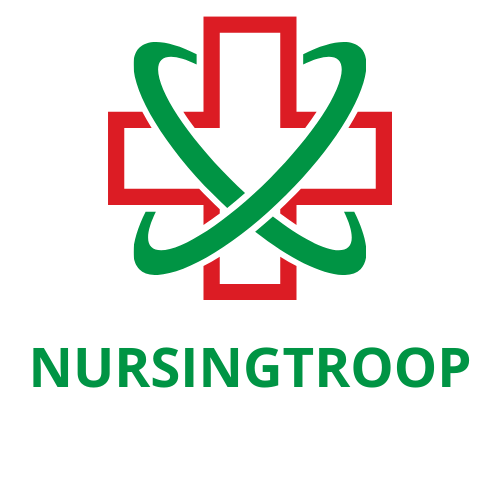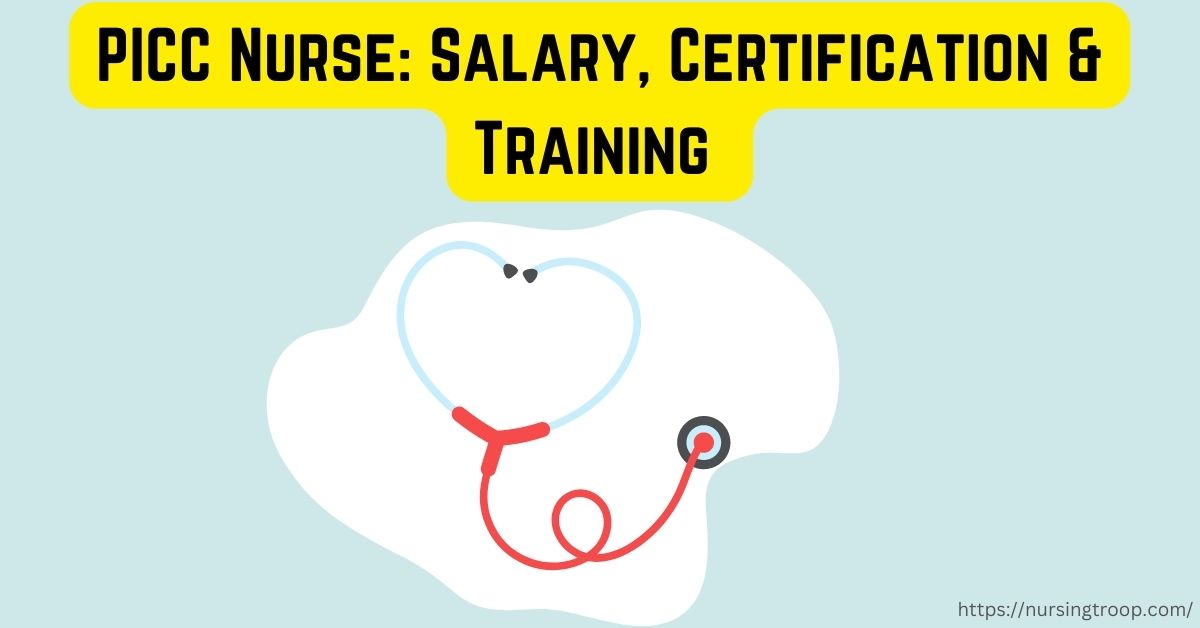One of the most essential roles in nursing is becoming a PICC Nurse. If you’re considering taking on this specialized role, you need to be informed about what it entails and know how to take the necessary steps to enter this vital field of healthcare.
In this blog post, we’ll cover what PICC Nurses do, the job responsibilities they carry out day-to-day, and the five steps required to become a PICC Nurse. Whether your goal is to obtain certification or just learn more about working as a nurse with peripherally inserted central catheters (PICCs), read on for all the information you’ll need.
Table of Contents
What is a PICC Nurse?
PICC Nurses are nurses who specialize in the placement, maintenance, and management of peripherally inserted central catheters (PICCs). A PICC nurse assists patients, families, and team members with all aspects of PICC care.
This includes helping to identify and select the correct PICC, teaching patients how to care for their catheter, monitoring for any potential complications, performing routine dressing changes and flushes of the line, and coordinating any necessary removal. They also provide education on proper maintenance techniques and ensure safety protocols are followed.
PICC Line Nurse Job Duties
A PICC line nurse typically has a wide range of responsibilities, which can include:
- Monitoring the patient’s blood pressure, heart rate, and other vital signs to detect any changes that might indicate complications
- Educating patients on how to care for their PICC line and any potential risks that might be associated with it
- They are collecting blood samples from patients for analysis by a laboratory.
- Inserting the PICC line into a patient’s arm or chest according to evidence-based practice guidelines
- Maintaining the PICC line insertion site, dressing changes, flushing the catheter, and other daily activities related to its maintenance
- Monitoring the patient’s response to medications administered through their PICC line
- Documenting all aspects of the patient’s care related to their PICC line following hospital policies
- Having conversations with patients about their condition and offering emotional support Evaluating the need for medical referrals or additional treatments for complications due to their PICC line
- Collaborating with other healthcare team members to ensure the patient receives comprehensive care.
How To Become a PICC Nurse?
Picc Stands for “Peripherally inserted central catheter,” so becoming a PICC Nurse requires specialized knowledge and skills in this field. To become a PICC Nurse, you must complete the following five steps:
Step 1: Obtain an RN degree.
To become a PICC Nurse, the first step is to get an education that will prepare you for the career. A Registered Nursing degree is required and typically consists of earning either an Associate’s Degree in Nursing (ADN) or a Bachelor’s Degree in Nursing (BSN).
Step 2: Obtain Licensure
To become a PICC Nurse, you must be licensed in the state where you plan to practice. This requires obtaining and passing the NCLEX-RN exam. Additionally, most states require licensure renewal every few years, which may include meeting continuing education requirements.
Step 3: Take a PICC Nursing Course
You must gain experience in working with peripherally inserted central catheters (PICCs). Taking an accredited PICC Nurse course is one way to do so.
These courses are typically offered as part of nursing programs or through external organizations such as the Infusion Nurses Society or the American Society for Parenteral and Enteral Nutrition.
Step 4: Get Certified
In order to be recognized as a certified PICC Nurse, you must pass an exam administered by the Infusion Nurses Certification Corporation (INCC). After passing this exam, you’ll be eligible for certification and receive a credential that recognizes your expertise in PICC care.
Additionally, INCC offers recertification every five years. In your certification program, you complete courses and clinical experience to learn how to:
• Recognize normal and abnormal physiology related to the insertion, use, and care of PICC devices
• Evaluate patient-specific factors that influence selection, insertion, use, and care for safe deployment of PICC lines
• Develop treatment plans based on evidence-based practice for patients with peripherally inserted central catheters
• Implement PICC line management protocols to minimize the risk of infection
• Maintain competency and knowledge related to current evidence-based practice guidelines for peripherally inserted central catheter care
Step 5: Maintain certification or licensure
Even after you receive employment as a PICC nurse, you must maintain your certification or licensure. You can achieve this through continuing your education, retaking certification exams, or proving your employment as a PICC nurse. Nurse maintenance requirements differ per state, so stay informed and ask your employer about the requirements to maintain your certification or licensure.
Despite the different qualifications, some common ways to maintain your license include taking continuing education courses, keeping up to date with changes in the field, and engaging in professional development activities. You should also keep track of your hours and other requirements for each state you practice.
Here are some other common options that you can maintain your nursing license:
- Continue to learn and keep up with the latest advancements in your field
- Join professional organizations
- Retaking certified nursing courses
- Mentor or teach others
- Engage in research projects or other scholarly activities
- Attend nursing conferences and seminars
- Completing a specified number of contact or practice hours every two or more years
Essential Skills for a PICC Nurse
Some skills that can help PICC nurses succeed may include:
- Communication: PICC nurses must communicate effectively with patients and other healthcare professionals.
- Technical Expertise: Knowing how to properly use the equipment necessary for performing a procedure, such as inserting a PICC line, is essential.
- Critical Thinking: Being able to think critically in order to make quick decisions based on evidence-based practice guidelines can help ensure that patient care remains safe and effective.
- Organizational Skills: Organizing tasks and prioritizing them according to their importance is important for staying on top of all responsibilities.
- Compassion: Demonstrating empathy towards patients while providing care can go a long way in helping improve their experience during treatment.
- Adaptability: The healthcare industry is ever-changing, so adapting quickly and staying up to date with the latest advancements in the field will help PICC nurses keep up.
Average Salary and Job Outlook for a PICC Nurse
According to national data, PICC nurses earn an average of $94,501 annually. However, this salary may vary depending on the person’s level of education and experience as well as their location.
Moreover, the US Bureau of Labor Statistics (BLS) suggests that positions for nurses, such as PICC nurses, may increase by 7% from 2019 to 2029, a faster growth rate than most other jobs. This surge in demand can likely be attributed to the aging population and their growing need for nursing care.
PICC Line Nurse Work Environment
PICC line nurses typically work in hospitals or medical centers, providing care to patients with long-term illnesses. They may also work at outpatient clinics or doctor’s offices. PICC nurses are usually expected to work full-time; however, they can also find part-time positions or on-call.
They also work with potentially hazardous chemicals and equipment and must take safety precautions to protect themselves and their patients. Additionally, they may need to stand or walk for extended periods of time to assist with patient care.
PICC line nurses are essential members of a healthcare team whose work helps ensure that patients receive the best possible care. With a dedication to continuing education and expertise in their field, they help foster a positive environment for the patients they serve.
Frequently Asked Questions of Students to Become PICC NURSE
What is PICC line training?
PICC line training is a course of study that helps nurses learn the skills and knowledge necessary for performing procedures such as inserting a PICC line. It typically consists of both classroom instruction and hands-on practice. During the course, nurses will learn how to properly insert, maintain, troubleshoot, and remove PICC lines while following the latest evidence-based practice guidelines.
How long is PICC line training?
Training programs for PICC insertion qualify clinicians to insert PICC lines, but it is important to note that this training should not be mistaken for PICC line insertion certification.
In a 2 days classroom setting, the program covers didactic instruction as well as one-on-one supervised practice and testing that meets INFUSIONNURSESOCIETY/INS globally accepted infusion therapy standards. This comprehensive hands-on training teaches the modified Seldinger technique (MST) for inserting PICC lines and midline catheters.
Upon successful completion of the 2-day PICC line insertion course, participants will receive a certificate. After this point, they can start supervised insertion and competency validation in any clinical setting according to the facility’s policy and procedures.
Can nurses do PICC?
Yes, nurses can do PICC lines. Nurses who have specialized training in vascular access technology are allowed to insert a peripherally inserted central catheter (PICC). But they must complete the appropriate coursework and obtain certification for PICC insertion.
However, it is important to note that each state or country has its own regulations regarding who is allowed to insert PICC lines. It is best to consult your state board of nursing or other regulating body for specific rules and regulations in your area.
Can any nurse remove a PICC line?
PICCs should be removed by a physician or trained registered nurse. The nurse must be familiar with the principles of PICC line removal, as well as infection control and patient comfort. In some healthcare settings, specially trained nurses may also remove PICCs. It is important to speak with your institution’s policies regarding who can remove a PICC before attempting to do so.
What certifications are needed to work as a PICC line nurse?
In order to become certified as a PICC Line Nurse, you must successfully complete the Infusion Nurses Society’s (INS) Certified Registered Nurse Infusion (CRNI®) certification examination. The CRNI exam is designed to ensure nurses maintain the highest standards of practice in the field of infusion therapy.
In addition, many employers may require nurses to have additional certifications such as ACLS (Advanced Cardiac Life Support) and BLS (Basic Life Support). To learn more about these certifications, visit the American Heart Association’s website.
Final Thoughts
PICC line nurses are essential members of the healthcare team. They help ensure patients receive the best care by providing expert services and maintaining current evidence-based practice guidelines.
If you’re looking to become a PICC line nurse, it’s essential to understand the necessary training, certifications, and protocols involved to provide the best care possible.
By completing the appropriate training and certification, you can become a knowledgeable and skilled PICC line nurse that patients can rely on.
Mrs. Marie Brown has been a registered nurse for over 25 years. She began her nursing career at a Level I Trauma Center in downtown Chicago, Illinois. There she worked in the Emergency Department and on the Surgical Intensive Care Unit. After several years, she moved to the Midwest and continued her nursing career in a critical care setting. For the last 10 years of her nursing career, Mrs. Brown worked as a flight nurse with an air ambulance service. During this time, she cared for patients throughout the United States.

